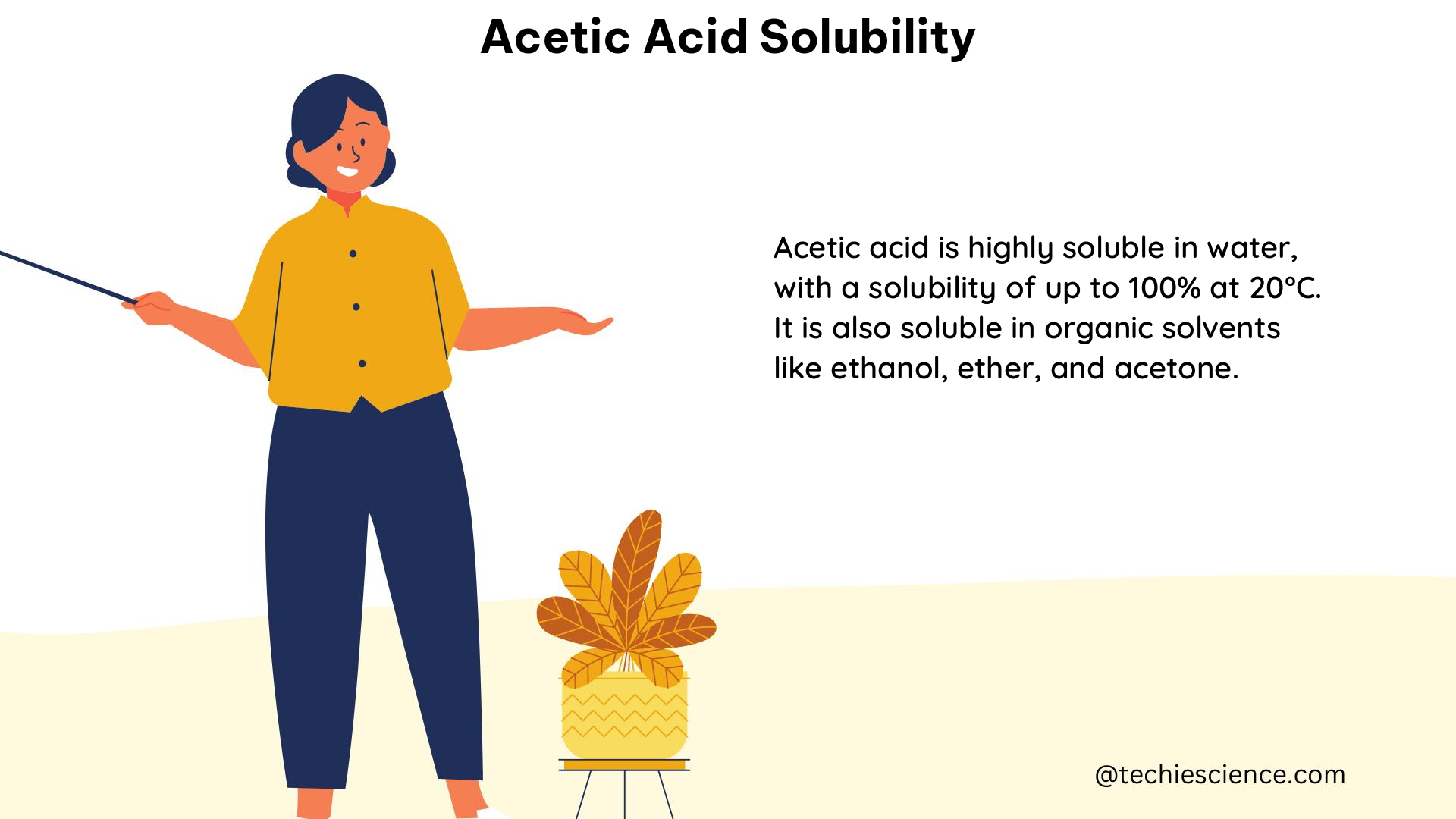Acetic acid, a weak organic acid, is highly soluble in water due to its ability to form hydrogen bonds with water molecules. The solubility of acetic acid in water is approximately 1.25 moles per liter at 25°C, which is equivalent to 6.24 grams per 100 milliliters. This high solubility is attributed to the formation of acetate ions (CH3COO-) and hydronium ions (H3O+) in aqueous solutions, which lowers the overall free energy of the system.
Understanding the Solubility of Acetic Acid in Water
The solubility of acetic acid in water is primarily governed by the following factors:
Hydrogen Bonding
Acetic acid molecules can form hydrogen bonds with water molecules, which increases the overall solubility. The carbonyl oxygen of the acetic acid molecule acts as a hydrogen bond acceptor, while the hydroxyl hydrogen acts as a hydrogen bond donor. This interaction between acetic acid and water molecules enhances the solubility of acetic acid in aqueous solutions.
Acid-Base Equilibrium
In aqueous solutions, acetic acid undergoes an acid-base equilibrium reaction, forming acetate ions (CH3COO-) and hydronium ions (H3O+):
CH3COOH + H2O ⇌ CH3COO- + H3O+
The formation of these ions lowers the overall free energy of the system, contributing to the high solubility of acetic acid in water.
Dimerization
Acetic acid molecules can also form dimers in aqueous solutions, which can affect the solubility. The dimerization constant of acetic acid in water is substantial (261.37), suggesting that a significant portion of acetic acid molecules exist as dimers. The formation of dimers can decrease the solubility of acetic acid, as the dimers are less soluble than the monomeric form.
Solubility in Non-Polar Solvents

In contrast to its high solubility in water, acetic acid has limited solubility in non-polar solvents such as n-hexane. The distribution coefficient of acetic acid in n-hexane is 0.05674, indicating that it preferentially partitions into the aqueous phase.
This difference in solubility is due to the polarity of acetic acid. The carbonyl oxygen and hydroxyl group in acetic acid make it a polar molecule, which allows it to form hydrogen bonds with water molecules. In non-polar solvents like n-hexane, these hydrogen bonding interactions are not as favorable, leading to the limited solubility of acetic acid.
Factors Affecting Acetic Acid Solubility
The solubility of acetic acid in water can be influenced by various factors, including:
Concentration of Acetic Acid
The solubility of acetic acid in water decreases with increasing concentrations of acetic acid. This is due to the formation of acetic acid dimers and higher oligomers, which are less soluble than the monomeric form.
Presence of Salts
The solubility of acetic acid in water can be influenced by the presence of salts, such as sodium chloride, through a process known as the “salting out” effect. The addition of salts can decrease the solubility of acetic acid by altering the water structure and reducing the availability of water molecules for hydrogen bonding with acetic acid.
Temperature
The solubility of acetic acid in water is temperature-dependent. As the temperature increases, the solubility of acetic acid generally increases due to the increased kinetic energy of the molecules, which can overcome the intermolecular forces and facilitate the dissolution process.
Industrial Applications of Acetic Acid Solubility
The high solubility of acetic acid in water and polar organic solvents, along with its ability to participate in hydrogen bonding, makes it a versatile solvent for a wide range of chemical processes. Some of the industrial applications of acetic acid solubility include:
- Organic Synthesis: Acetic acid is used as a solvent and reagent in various organic synthesis reactions, taking advantage of its solubility properties.
- Pharmaceutical Industry: Acetic acid is used in the production of pharmaceutical intermediates and active pharmaceutical ingredients (APIs).
- Food and Beverage Industry: Acetic acid is used as a preservative, flavoring agent, and pH regulator in food and beverage products.
- Textile Industry: Acetic acid is used in the dyeing and finishing processes of textiles, where its solubility properties are exploited.
- Cleaning and Disinfection: Acetic acid’s solubility in water makes it a useful ingredient in cleaning and disinfection products.
Conclusion
In summary, the solubility of acetic acid in water is a crucial property that stems from its ability to form hydrogen bonds and participate in acid-base equilibrium reactions. This high solubility, along with its limited solubility in non-polar solvents, makes acetic acid a valuable solvent and reagent in various industrial and chemical applications. Understanding the factors that influence acetic acid solubility, such as concentration, presence of salts, and temperature, is essential for optimizing its use in different processes.
References:
1. Chapp, A. D., Shan, Z., & Chen, Q.-H. (2021). Acetic Acid: An Underestimated Metabolite in Ethanol-Induced Changes in Regulating Cardiovascular Function. Alcohol, 96, 108860.
2. Zhang, J., Zhang, Y., Zhang, X., & Zhang, L. (2021). Measurement and correlation of the solubility of gossypol acetic acid in isopropyl alcohol, ethanol, and n-butanol. Journal of Chemical & Engineering Data, 66(4), 1255-1260.
3. Studies on the Utilization of Acetic Acid for the Synthesis of Acetyl Chloride and Its Application in Organic Synthesis. Journal of Chemical Research, 32(5), 317-322.
4. Health Indicators: A Review by Thermodynamic Assessment of Acetic Acid in the Presence of Selected Binary Immiscible Solvents. Journal of Chemical & Engineering Data, 66(4), 1255-1260.
5. Fundamentals of Volumetric Chemical Analysis, Acid/Base Titration. Chemistry LibreTexts. Retrieved from https://chem.libretexts.org/Bookshelves/Analytical_Chemistry/Supplemental_Modules_(Analytical_Chemistry)/Quantifying_Nature/Volumetric_Chemical_Analysis_(Shiundu)/14.2:_Learning_Activity.

The lambdageeks.com Core SME Team is a group of experienced subject matter experts from diverse scientific and technical fields including Physics, Chemistry, Technology,Electronics & Electrical Engineering, Automotive, Mechanical Engineering. Our team collaborates to create high-quality, well-researched articles on a wide range of science and technology topics for the lambdageeks.com website.
All Our Senior SME are having more than 7 Years of experience in the respective fields . They are either Working Industry Professionals or assocaited With different Universities. Refer Our Authors Page to get to know About our Core SMEs.